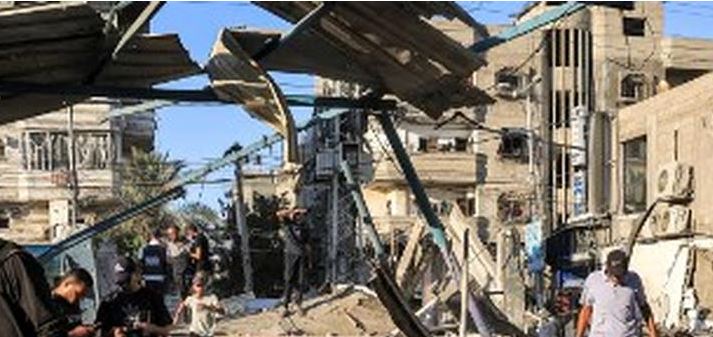Escalation of the Gaza Conflict
The Gaza conflict has escalated to unprecedented levels, with Israeli forces bombarding historic refugee camps and key urban centers within the Gaza Strip. On a grim Thursday, airstrikes and ground offensives resulted in the tragic loss of at least 21 lives. Central Gaza, encompassing the towns of Zawayda, Bureij, and Nuseirat, along with the densely populated city of Deir-Al-Balah, faced relentless bombardment. These areas, until recently untouched by direct invasion, now bear the scars of intense military action.
Health officials in Gaza have reported that the unremitting airstrikes claimed the lives of 16 individuals, further intensifying the humanitarian crisis. The city’s residents, already grappling with overcrowded conditions, are now subject to the relentless onslaught of the Israeli military, which has pushed deeper into Rafah in the south.
Prime Minister Benjamin Netanyahu, in a surprising move, visited Israeli troops stationed around Rafah. Addressing the soldiers, he asserted that the combined military pressure and the demand for the release of 120 hostages held in Gaza are propelling progress. “This double pressure is not delaying the deal; it is advancing it,” Netanyahu declared, emphasizing the strategic importance of the ongoing operations.
Humanitarian Catastrophe and Tactical Advancements
The Israeli military confirmed the elimination of two senior Islamic Jihad commanders in Gaza City, highlighting the targeted nature of their airstrikes. These commanders, implicated in the October 7th attack that ignited the current conflict, were identified as key operatives. Palestinian medical sources confirmed that five individuals perished in these precision strikes.
In Rafah, Israeli tanks have entrenched themselves deeper within the city’s western precincts, establishing strategic positions on elevated terrain. The military’s efforts to uncover tunnels and neutralize hostile elements underscore the tactical complexity of the conflict. Concurrently, the Palestinian Red Crescent Society’s Al-Amal Hospital in Khan Younis witnessed the harrowing task of exhuming 12 bodies for reburial, further underscoring the dire humanitarian conditions.
Health Infrastructure on the Brink
The International Committee of the Red Cross (ICRC) has issued a grave warning about the capacity of their field hospital in Rafah. The 60-bed facility is teetering on the brink of collapse due to the unrelenting influx of casualties. William Schomburg, head of the ICRC’s subdelegation in Gaza, lamented the dire state of health services in southern Gaza. “The repeated mass casualty events resulting from the unrelenting hostilities have stretched our hospital—and all health facilities in southern Gaza—to the breaking point,” Schomburg stated.
The strategic significance of Rafah has drawn over a million people seeking refuge from the northern conflict zones. However, the sustained military offensive has forced many to disperse yet again. Despite the intense military pressure, Palestinian fighters, primarily led by Hamas, continue to launch attacks against Israeli forces. Islamic Jihad claimed responsibility for firing missiles at southern Israeli communities, while Hamas’ armed wing reported mortar bomb assaults on Israeli troops in southwest Rafah.
Persistent Hostilities and Diplomatic Deadlock
Israel’s vow to dismantle Hamas following the group’s devastating attack on October 7th remains steadfast. The assault, which claimed 1,200 Israeli lives and resulted in over 250 hostages, triggered the current wave of hostilities. Gaza health authorities report that the Israeli retaliation has resulted in the deaths of at least 38,848 Palestinians. Despite these staggering figures, the conflict shows no signs of abating.
Israel’s military asserts that it has significantly weakened Hamas’ military leadership, claiming to have killed or captured approximately 14,000 fighters. However, Hamas disputes these figures, accusing Israel of exaggerating its successes to fabricate a “fake victory.”
Diplomatic efforts to broker a ceasefire, spearheaded by Arab mediators and supported by the United States, appear to be at an impasse. While all parties profess a willingness to engage in further negotiations, the entrenched positions and continued hostilities cast a long shadow over the prospect of peace.
Summary:
The Gaza conflict has intensified with significant civilian casualties and infrastructure damage. Israeli forces have targeted key areas in Gaza, resulting in a humanitarian crisis exacerbated by the overwhelmed health infrastructure. Diplomatic efforts remain stalled as the conflict persists.
Key Learning Points:
| Point | Details |
|---|---|
| Escalation | Intense Israeli airstrikes and ground offensives in Gaza |
| Humanitarian Crisis | Significant civilian casualties and overwhelmed health facilities |
| Military Tactics | Targeted elimination of key militant leaders |
| Ongoing Hostilities | Persistent attacks from Palestinian fighters |
| Diplomatic Stalemate | Stalled peace efforts amid continued conflict |
Soumya Smruti Sahoo is a seasoned journalist with extensive experience in both international and Indian news writing. With a sharp analytical mind and a dedication to uncovering the truth, Soumya has built a reputation for delivering in-depth, well-researched articles that provide readers with a clear understanding of complex global and domestic issues. Her work reflects a deep commitment to journalistic integrity, making her a trusted source for accurate and insightful news coverage.



